Abstract
The products of the ipaB, ipaC, and ipaD genes are involved in the expression of the invasive phenotype in all species of Shigella and enteroinvasive Escherichia coli (EIEC). DNA probes derived from these genes are accurate indicators of the invasive phenotype (M. Venkatesan, J. M. Buysse, E. V. Vandendries, and D. J. Kopecko, J. Clin. Microbiol. 26:261-266, 1988); however, spontaneous loss of the invasion plasmid or selective deletion of invasion-associated genes may restrict the usefulness of such probes as general diagnostic tools. In this study, we report that laboratory-passaged strains of Shigella spp. and EIEC that were invasion and Sereny test negative were unable to hybridize to the ipaC DNA probe. However, a second DNA probe, derived from the Shigella flexneri ipaH gene, a multiple-copy element found on the chromosome and invasion plasmid that encodes a 60-kilodalton antigen, was more sensitive in its ability to detect virulent as well as avirulent shigellae and EIEC. Analysis of colony blots and stool blots from pediatric patients with diarrhea indicated that the ipaH probe was more effective in detecting shigellae and EIEC than was either the ipaC or 17-kilobase EcoRI fragment probe.
Full text
PDF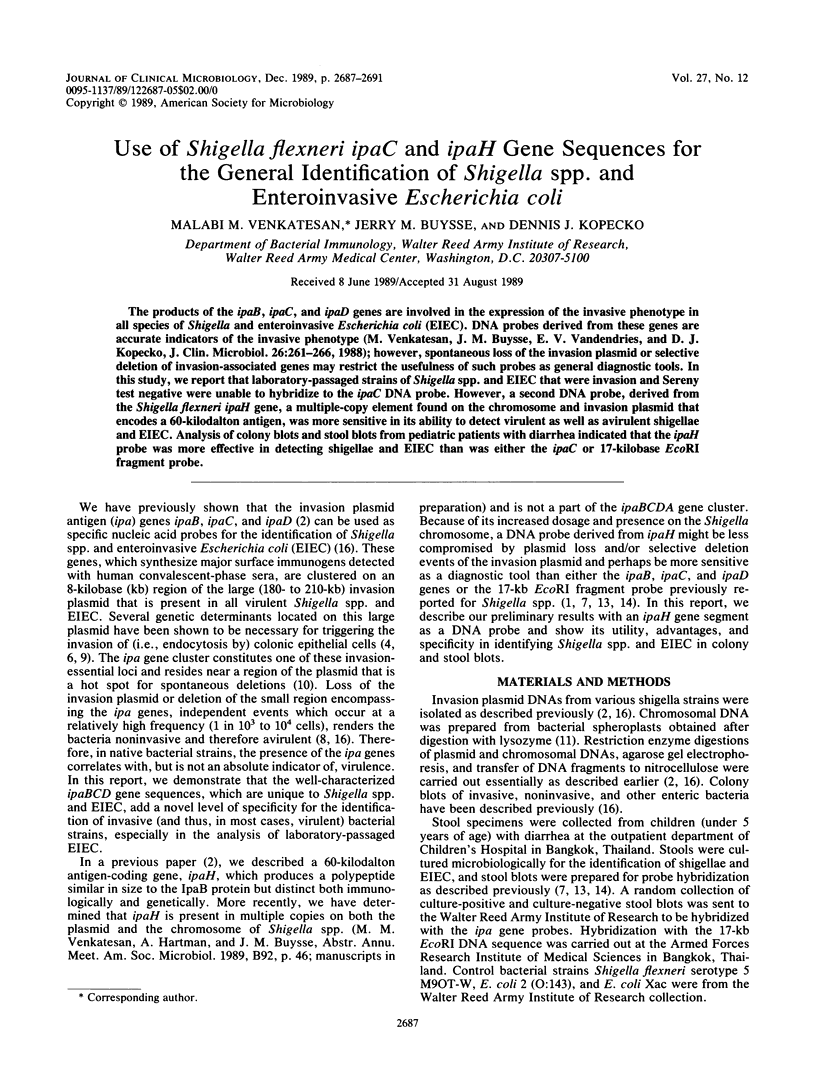
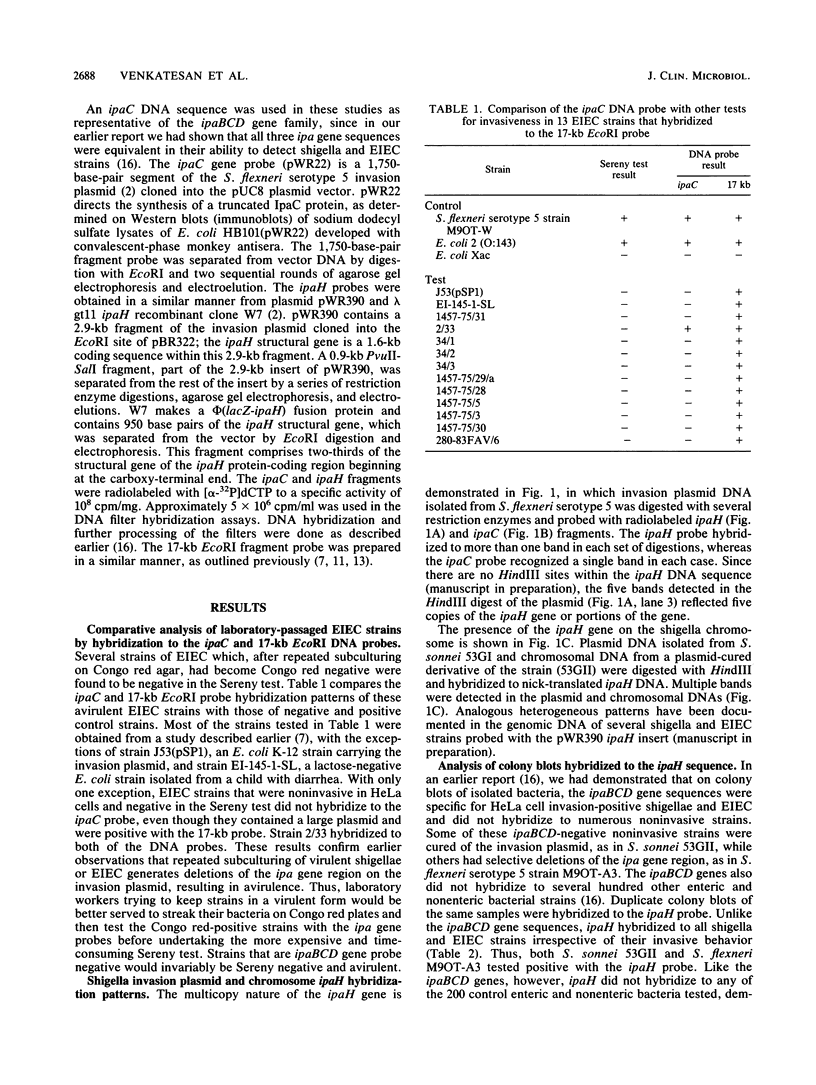
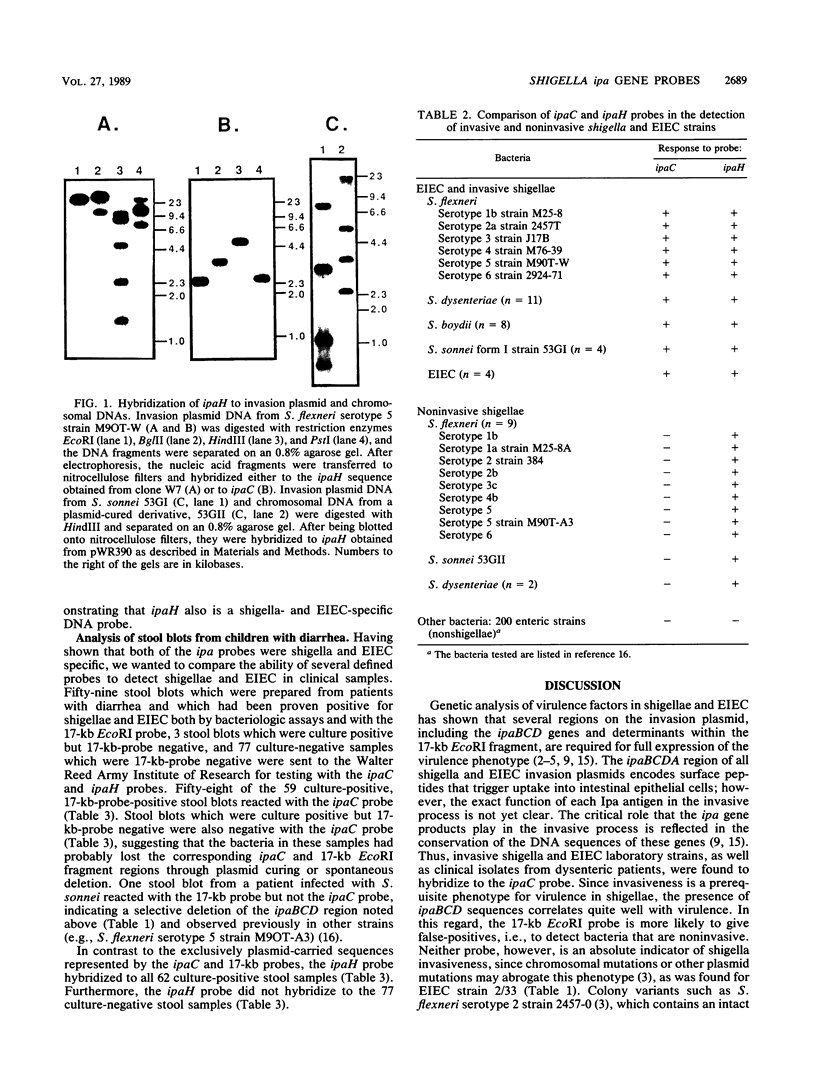
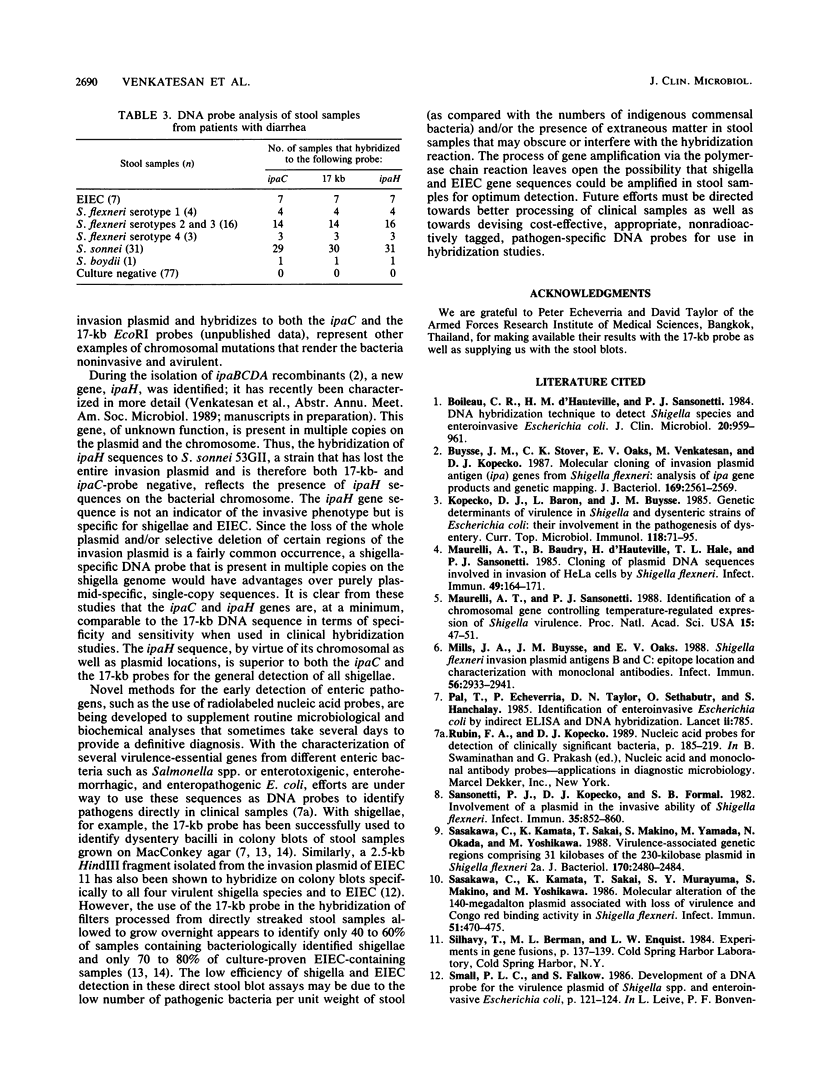
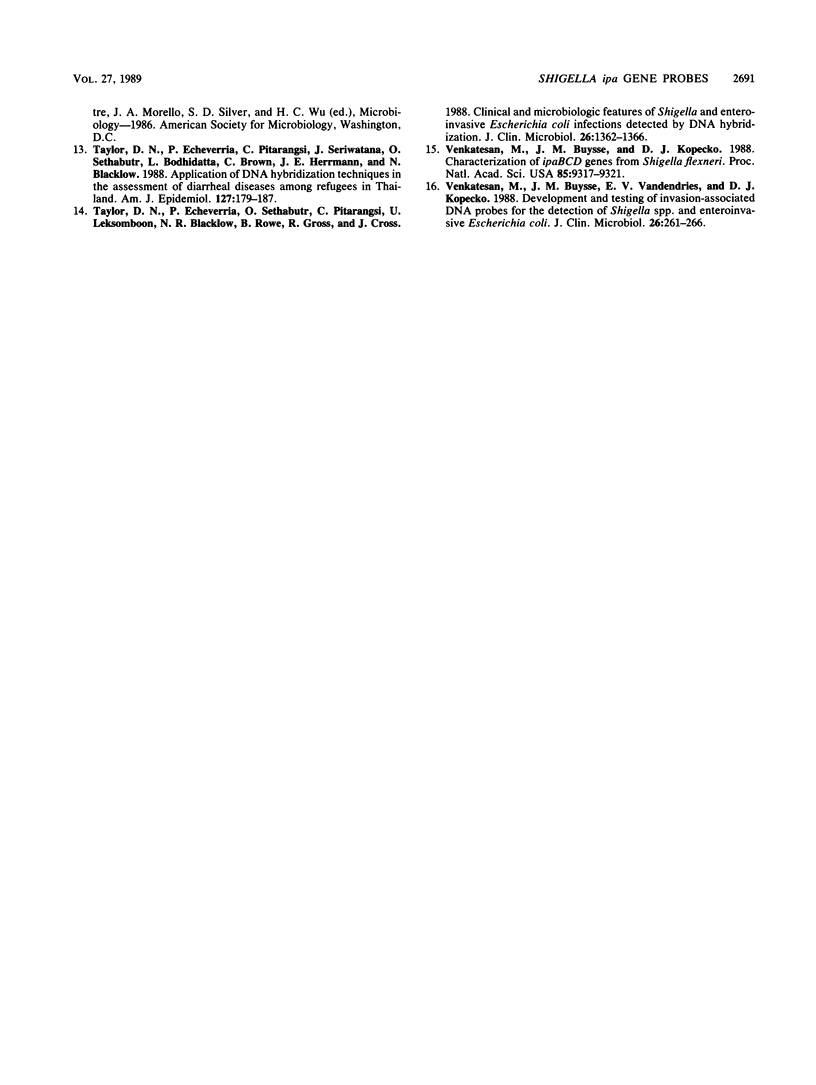
Images in this article
Selected References
These references are in PubMed. This may not be the complete list of references from this article.
- Boileau C. R., d'Hauteville H. M., Sansonetti P. J. DNA hybridization technique to detect Shigella species and enteroinvasive escherichia coli. J Clin Microbiol. 1984 Nov;20(5):959–961. doi: 10.1128/jcm.20.5.959-961.1984. [DOI] [PMC free article] [PubMed] [Google Scholar]
- Buysse J. M., Stover C. K., Oaks E. V., Venkatesan M., Kopecko D. J. Molecular cloning of invasion plasmid antigen (ipa) genes from Shigella flexneri: analysis of ipa gene products and genetic mapping. J Bacteriol. 1987 Jun;169(6):2561–2569. doi: 10.1128/jb.169.6.2561-2569.1987. [DOI] [PMC free article] [PubMed] [Google Scholar]
- Kopecko D. J., Baron L. S., Buysse J. Genetic determinants of virulence in Shigella and dysenteric strains of Escherichia coli: their involvement in the pathogenesis of dysentery. Curr Top Microbiol Immunol. 1985;118:71–95. doi: 10.1007/978-3-642-70586-1_5. [DOI] [PubMed] [Google Scholar]
- Maurelli A. T., Baudry B., d'Hauteville H., Hale T. L., Sansonetti P. J. Cloning of plasmid DNA sequences involved in invasion of HeLa cells by Shigella flexneri. Infect Immun. 1985 Jul;49(1):164–171. doi: 10.1128/iai.49.1.164-171.1985. [DOI] [PMC free article] [PubMed] [Google Scholar]
- Mills J. A., Buysse J. M., Oaks E. V. Shigella flexneri invasion plasmid antigens B and C: epitope location and characterization with monoclonal antibodies. Infect Immun. 1988 Nov;56(11):2933–2941. doi: 10.1128/iai.56.11.2933-2941.1988. [DOI] [PMC free article] [PubMed] [Google Scholar]
- Pal T., Echeverria P., Taylor D. N., Sethabutr O., Hanchalay S. Identification of enteroinvasive Escherichia coli by indirect ELISA and DNA hybridisation. Lancet. 1985 Oct 5;2(8458):785–785. doi: 10.1016/s0140-6736(85)90669-5. [DOI] [PubMed] [Google Scholar]
- Sansonetti P. J., Kopecko D. J., Formal S. B. Involvement of a plasmid in the invasive ability of Shigella flexneri. Infect Immun. 1982 Mar;35(3):852–860. doi: 10.1128/iai.35.3.852-860.1982. [DOI] [PMC free article] [PubMed] [Google Scholar]
- Sasakawa C., Kamata K., Sakai T., Makino S., Yamada M., Okada N., Yoshikawa M. Virulence-associated genetic regions comprising 31 kilobases of the 230-kilobase plasmid in Shigella flexneri 2a. J Bacteriol. 1988 Jun;170(6):2480–2484. doi: 10.1128/jb.170.6.2480-2484.1988. [DOI] [PMC free article] [PubMed] [Google Scholar]
- Sasakawa C., Kamata K., Sakai T., Murayama S. Y., Makino S., Yoshikawa M. Molecular alteration of the 140-megadalton plasmid associated with loss of virulence and Congo red binding activity in Shigella flexneri. Infect Immun. 1986 Feb;51(2):470–475. doi: 10.1128/iai.51.2.470-475.1986. [DOI] [PMC free article] [PubMed] [Google Scholar]
- Taylor D. N., Echeverria P., Pitarangsi C., Seriwatana J., Sethabutr O., Bodhidatta L., Brown C., Herrmann J. E., Blacklow N. R. Application of DNA hybridization techniques in the assessment of diarrheal disease among refugees in Thailand. Am J Epidemiol. 1988 Jan;127(1):179–187. doi: 10.1093/oxfordjournals.aje.a114779. [DOI] [PubMed] [Google Scholar]
- Taylor D. N., Echeverria P., Sethabutr O., Pitarangsi C., Leksomboon U., Blacklow N. R., Rowe B., Gross R., Cross J. Clinical and microbiologic features of Shigella and enteroinvasive Escherichia coli infections detected by DNA hybridization. J Clin Microbiol. 1988 Jul;26(7):1362–1366. doi: 10.1128/jcm.26.7.1362-1366.1988. [DOI] [PMC free article] [PubMed] [Google Scholar]
- Venkatesan M. M., Buysse J. M., Kopecko D. J. Characterization of invasion plasmid antigen genes (ipaBCD) from Shigella flexneri. Proc Natl Acad Sci U S A. 1988 Dec;85(23):9317–9321. doi: 10.1073/pnas.85.23.9317. [DOI] [PMC free article] [PubMed] [Google Scholar]
- Venkatesan M., Buysse J. M., Vandendries E., Kopecko D. J. Development and testing of invasion-associated DNA probes for detection of Shigella spp. and enteroinvasive Escherichia coli. J Clin Microbiol. 1988 Feb;26(2):261–266. doi: 10.1128/jcm.26.2.261-266.1988. [DOI] [PMC free article] [PubMed] [Google Scholar]



